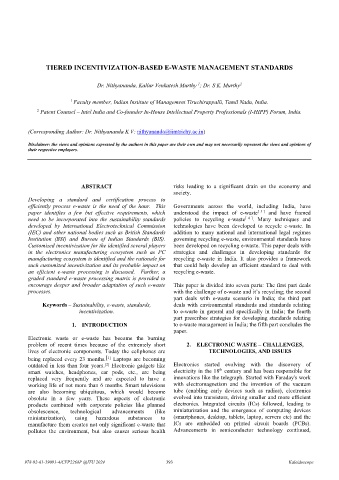Page 437 - Kaleidoscope Academic Conference Proceedings 2024
P. 437
TIERED INCENTIVIZATION-BASED E-WASTE MANAGEMENT STANDARDS
2
Dr. Nithyananda, Kallur Venkatesh Murthy ; Dr. S K. Murthy
1
1 Faculty member, Indian Institute of Management Tiruchirappalli, Tamil Nadu, India.
2 Patent Counsel – Intel India and Co-founder In-House Intellectual Property Professionals (I-HIPP) Forum, India.
(Corresponding Author: Dr. Nithyananda K V: nithyananda@iimtrichy.ac.in)
Disclaimer: the views and opinions expressed by the authors in this paper are their own and may not necessarily represent the views and opinions of
their respective employers.
ABSTRACT risks leading to a significant drain on the economy and
society.
Developing a standard and certification process to
efficiently process e-waste is the need of the hour. This Governments across the world, including India, have
paper identifies a few but effective requirements, which understood the impact of e-waste [ 3 ] and have framed
need to be incorporated into the sustainability standards policies to recycling e-waste [ 4 ] . Many techniques and
developed by International Electrotechnical Commission technologies have been developed to recycle e-waste. In
(IEC) and other national bodies such as British Standards addition to many national and international legal regimes
Institution (BSI) and Bureau of Indian Standards (BIS). governing recycling e-waste, environmental standards have
Customized incentivization for the identified several players been developed on recycling e-waste. This paper deals with
in the electronics manufacturing ecosystem such as PC strategies and challenges in developing standards for
manufacturing ecosystem is identified and the rationale for recycling e-waste in India. It also provides a framework
such customized incentivization and its probable impact on that could help develop an efficient standard to deal with
an efficient e-waste processing is discussed. Further, a recycling e-waste.
graded standard e-waste processing matrix is provided to
encourage deeper and broader adaptation of such e-waste This paper is divided into seven parts: The first part deals
processes. with the challenge of e-waste and it’s recycling; the second
part deals with e-waste scenario in India; the third part
Keywords – Sustainability, e-waste, standards, deals with environmental standards and standards relating
incentivization. to e-waste in general and specifically in India; the fourth
part prescribes strategies for developing standards relating
1. INTRODUCTION to e-waste management in India; the fifth part concludes the
paper.
Electronic waste or e-waste has become the burning
problem of recent times because of the extremely short 2. ELECTRONIC WASTE – CHALLENGES,
lives of electronic components. Today the cellphones are TECHNOLOGIES, AND ISSUES
being replaced every 23 months. Laptops are becoming
[1]
outdated in less than four years. Electronic gadgets like Electronics started evolving with the discovery of
[2]
th
smart watches, headphones, ear pods, etc., are being electricity in the 18 century and has been responsible for
replaced very frequently and are expected to have a innovations like the telegraph. Started with Faraday's work
working life of not more than 6 months. Smart televisions with electromagnetism and the invention of the vacuum
are also becoming ubiquitous, which would become tube (enabling early devices such as radios), electronics
obsolete in a few years. These aspects of electronic evolved into transistors, driving smaller and more efficient
products combined with corporate policies like planned electronics. Integrated circuits (ICs) followed, leading to
obsolescence, technological advancements (like miniaturization and the emergence of computing devices
miniaturization), using hazardous substances to (smartphones, desktop, tablets, laptop, servers etc) and the
manufacture them creates not only significant e-waste that ICs are embedded on printed circuit boards (PCBs).
pollutes the environment, but also causes serious health Advancements in semiconductor technology continued,
978-92-61-39091-4/CFP2268P @ITU 2024 – 393 – Kaleidoscope

